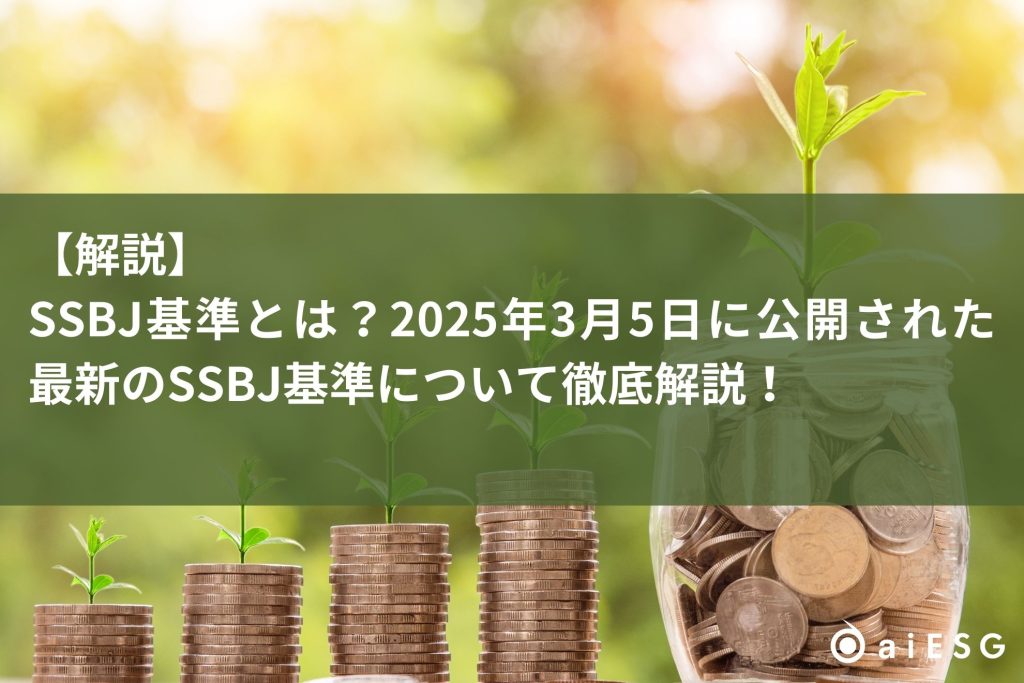INDEX
Taxonomy is a term that refers to a classification system and is used to classify sustainable economic activities. In addition to the most well-known EU taxonomy, other countries such as ASEAN and China are introducing their own taxonomies.
This article will take a closer look at the major taxonomies and their impact on Japanese companies.
Greenwash and Taxonomy
As ESG and sustainability become major indicators of economic activity, there is a growing concern about greenwashing. Greenwash is a combination of the words "green," which is associated with environmental benefits, and "whitewash," which means to deceive, and refers to the exaggeration of the reality or pretense of environmental friendliness. In order to prevent evaluations without supporting evidence, there has been a call for the creation of indicators to objectively classify sustainability.
Taxonomies primarily target business activities and use explicit criteria to assess whether or not a company's activities contribute to or negatively impact the environment. While taxonomies do not directly restrict investment in economic activities that are not assessed for sustainability, they can be used by investors to make decisions that may result in disadvantageous financing.
EU Taxonomy
The most well-known one is the European Union Taxonomy. This taxonomy regulation was developed as part of the Action Plan on Sustainable Finance[1] published in 2018 and has been updated while being gradually applied since its adoption in June 2020. The EU Taxonomy, finally approved in 2023, consists of six main environmental objectives and four items to be met.
Table 1 : Six environmental objectives and four items (Source:European Commission DocumentsandMinistry of the Environment dataPrepared by the author from)
| Environmental Objectives | |
| Climate Change Mitigation | Transition to a Circular Economy |
| Adaptation to Climate Change | Pollution Prevention and Control |
| Sustainable use and protection of water and marine resources | Biodiversity and Ecosystem Protection and Restoration |
| Items to be met | |
| 1. substantially contributes to one or more of the six environmental objectives → e.g., improving energy efficiency, protecting against pollution, etc. | |
| 2. no significant harm to any of the six environmental objectives (DNSH[2]) →no large amount of carbon dioxide emissions/inefficient use of raw materials, etc. | |
| 3. comply with minimum safety measures → Ensure human and other rights at work | |
| 4. meet professional selection criteria (minimum safeguard) → Criteria to meet 1 and 2 above. Presentation of scientific evidence | |
Specifically, four other environmental objectives have been added to the climate change mitigation and adaptation established in the first phase. In addition to the uniquely defined categories of green economic activities, the program requires reporting of sales and other information from activities that meet the requirements.
In addition to the above defined "Green Taxonomy," which classifies environmental sustainability, the introduction of a "Social Taxonomy," which evaluates social aspects, has also been considered. Although this taxonomy has not been officially updated since the release of the Final Report[3] in February 2022, the importance of the social aspects of ESG has been emphasized in the SFDR and CSRD, which are required to be addressed in the EU region, and should continue to be closely monitored.
Taxonomy of countries and regions
The taxonomy-setting movement is not limited to Europe, as various countries and regions are setting up their own taxonomies. In this chapter, we will discuss several taxonomies that have attracted attention and look at their current status and outlook.
ASEAN
ASEAN released the first edition of its own taxonomy in 2021 and updated it to a second edition[4] in 2023. Compared to the EU, which is leading the discussion on sustainability, Southeast Asia, a region with a rapidly growing population and economy, has very different issues to consider. All member countries participate in the ASEAN Taxonomy Board, which is the body responsible for reviewing the taxonomy, and it provides guiding concepts for each country to use when creating their own taxonomy. Singapore and Malaysia have already devised taxonomies for domestic financial institutions and are considering consistency with the ASEAN Taxonomy.
The ASEAN Taxonomy and the Singapore Taxonomy, which was developed around the same time as the ASEAN Taxonomy, are characterized by their incorporation of transition concepts, such as the existence of an "amber" rating, which is a step on the way to a "green" rating, and a "red" rating, meaning exit from the market. While sharing commonalities with the EU taxonomy, the EU taxonomy proposes a unique classification for efforts in industries that have few GHG reduction measures. In addition, the ASEAN Taxonomy provides the minimum Essential Criteria (EC) to be met: "no significant harm (DNSH)" and "compensatory measures for transition (RMT)" as well as "social aspects (SA)" (Figure 1).
Figure 1: Three main social aspects (SA) (Source:ASEAN Taxonomy MaterialsPrepared by the author from)
China
In China, the People's Bank of China (PBOC), in collaboration with the National Development and Reform Commission of China (NDRC) and the China Securities Regulatory Commission (CSRC), published a Chinese version of the taxonomy, the Green Bond Catalogue[5] in 2021. Compliance with this taxonomy is required in order to issue green bonds in China.
A "white list" has been created that classifies targeted economic activities in a four-level hierarchy beginning with six categories, including energy conservation, and a total of 204 programs indicate specific activities that fit the taxonomy.
United Kingdom
The UK has decided to introduce its own green taxonomy based on the EU taxonomy; in March 2023, the UK government announced its Green Finance Strategy [6], which requires voluntary reporting for at least two years after the taxonomy is finalized, and then, states that it will consider requiring disclosure. It has also announced its intention to include nuclear energy in the green taxonomy's investment targets.
Japan
Japan does not currently have a taxonomy or plans to introduce one, and in a PRI (Principles for Responsible Investment) 2022 survey of financial institutions investing in the Japanese market, about 60% of respondents supported the development of a sustainable finance taxonomy in Japan (Figure 2).
Figure 1: Opinions on the introduction of a sustainable finance taxonomy in Japan
(Source: PRI "The Need for a Sustainable Finance Taxonomy in Japan")
Impact on Japanese Companies
The impact of the introduction of taxonomy in each region on Japanese companies may include the following
1. impact of disclosure requirements in the EU
The most immediate impact is the EU Taxonomy reporting requirements: large companies based in the EU are subject to the Corporate Sustainability Reporting Directive (CSRD). From fiscal year 2024 onward, companies subject to the CSRD will be required to report on the conformity of their economic activities with the six environmental objectives of the EU Taxonomy.
CSRD is explained in more detail in the following article.
CSRD: The EU Sustainability Reporting Standard Just Before It Enters into Force - The Impact on Japanese Companies - | aiESG
Indirect Impact 1: Impact of EU Taxonomy
As mentioned above, the EU Taxonomy was established by the European Action Plan, but it may be used as a standard for companies and investors outside the EU in the future. Even companies that are not currently subject to the CSRD may be indirectly affected by the EU taxonomy, such as the emergence of NGOs and ESG assessment organizations that utilize the EU taxonomy, and requests from business partners in the EU to disclose their compliance rates.
3. indirect impact➁: impact of other taxonomies
As we saw in the previous chapter, many countries and regions outside the EU have created their own taxonomies. Even though these taxonomies are not legally binding, it is very costly for companies with global operations to understand the differences in evaluations and systems in each region and to consider how to respond to them. Especially in regions such as Asia and Latin America, where economic conditions and challenges differ from country to country, the design of each country's system is also progressing in a disparate manner, so a careful response is required.
Conclusion
This article provides an overview of the taxonomy, a system for classifying the sustainability of economic activities, and the characteristics of each country and region, as well as its impact on domestic companies. The scope of the taxonomy tends to expand to include other social aspects such as environmental objectives, human rights, and forced labor. Even companies that are not currently subject to the taxonomy may be required to report taxonomy compliance rates at the request of their investors or business partners. It is important to start considering as early as possible how your company's economic activities will be classified and what information will be required.
aiESG provides support from the basic taxonomy to actual disclosure.
Contact us:
https://aiesg.co.jp/contact/
Bibliography
[1]Sustainable finance: Commission's Action Plan for a greener and cleaner economy (europa.eu)
[2] "Do No Significant Harm"
[3]Platform on Sustainable Finance's report on social taxonomy (europa.eu)
[4]ASEAN Taxonomy for Sustainable Finance
[5]Green Bond Endorsed Projects Catalogue (2021 Edition)
[6]Green finance strategy - GOV.UK (www.gov.uk)
*Related Article*.
Report List : Regulations/Standards
https://aiesg.co.jp/topics/report/tag/基準-規制/
CSRD: The EU Sustainability Reporting Standard Just Before It Enters into Force: The Impact on Japanese Companies
https://aiesg.co.jp/topics/report/2301120_csrd/
SFDR: What are the EU Sustainable Finance Disclosure Rules?
~ESG-related information disclosure requirements for financial products
https://aiesg.co.jp/topics/report/2301222_sfdr/
Commentary] Overview of ESRS (European Sustainability Reporting Standards)
https://aiesg.co.jp/topics/report/2301120_csrd/
















